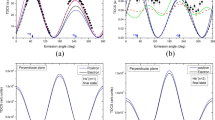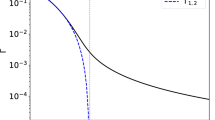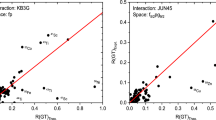Abstract
The deexcitation of single excited \(^{112}\)Sn nuclei at T = 1–30 MeV is simulated using the isospin-dependent quantum molecular dynamics (IQMD) model and GEMINI model. The fragmentation mechanism, critical behavior, and kinematic characteristics are investigated within these two models. The results show that the IQMD model can be applied to the analysis of fragmentation processes, critical points, and slope temperature extraction. The results of IQMD are generally consistent with experimental \(\langle M_{\text {IMF}}\rangle - Z_{\text {bound}}\) data. However, GEMINI can reproduce the experimental data better than IQMD for isotopic distributions.














Similar content being viewed by others
References
S.B. Kaufman, M.W. Weisfield, E.P. Steinberg et al., Nuclear reactions of \(^{197}{\rm Au}\) with 11.5- and 300-GeV protons. Phys. Rev. C 14, 1121 (1976). https://doi.org/10.1103/PhysRevC.14.1121
A.I. Warwick, H.H. Wiemann, H.H. Gutbrod et al., Breakup of spectator residues in relativistic nuclear collisions. Phys. Rev. C 27, 1083 (1983). https://doi.org/10.1103/PhysRevC.27.1083
R. Nebauer, J. Aichelin, Multifragmentation—what the data tell us about the different models. Nucl. Phys. A 681, 353 (2001). https://doi.org/10.1016/S0375-9474(00)00539-X
D.Q. Fang, W.Q. Shen, J. Feng et al., Isospin effect of fragmentation reactions induced by intermediate energy heavy ion and its disapperance. Phys. Rev. C 61, 044610 (2000). https://doi.org/10.1103/PhysRevC.61.044610
N. Marie, A. Chbihi, J.B. Natowitz et al., Experimental determination of fragment excitation energies in multifragmentation events. Phys. Rev. C 58, 256 (1998). https://doi.org/10.1103/PhysRevC.58.256
T.T. Ding, C.W. Ma, An improved thermometer for intermediate-mass fragments. Nucl. Sci. Tech. 27, 132 (2016). https://doi.org/10.1007/s41365-016-0142-2
K. Hagel, M. Gonin, R. Wada et al., Violent collisions and multifragment final states in the \(^{40}{\rm Ca}\) + \(^{40}{\rm Ca}\) reaction at 35 MeV/nucleon. Phys. Rev. C 50, 2017 (1994). https://doi.org/10.1103/PhysRevC.50.2017
M. Mocko, M.B. Tsang, L. Andronenko et al., Projectile fragmentation of \(^{40}{\rm Ca}\), \(^{48}{\rm Ca}\), \(^{58}{\rm Ni}\), and \(^{64}{\rm Ni}\) at 140 MeV/nucleon. Phys. Rev. C 74, 054612 (2006). https://doi.org/10.1103/PhysRevC.74.054612
P. Liu, J.H. Chen, Y.G. Ma et al., Production of light nuclei and hypernuclei at high intensity accelerator facility energy region. Nucl. Sci. Tech. 28, 55 (2017). https://doi.org/10.1007/s41365-017-0207-x
R. Ogul, N. Buyukcizmeci, A. Ergun et al., Production of neutron-rich exotic nuclei in projectile fragmentation at Fermi energies. Nucl. Sci. Tech. 28, 18 (2016). https://doi.org/10.1007/s41365-016-0175-6
Z.Q. Feng, Nuclear dynamics and particle production near threshold energies in heavy-ion collisions. Nucl. Sci. Tech. 29, 40 (2018). https://doi.org/10.1007/s41365-018-0379-z
C.W. Ma, Y.G. Ma, Shannon information entropy in heavy-ion collisions. Prog. Part. Nucl. Phys. 99, 120 (2018). https://doi.org/10.1016/j.ppnp.2018.01.002
J. Aichelin, “Quantum” molecular dynamics—a dynamical microscopic n-body approach to investigate fragment formation and the nuclear equation of state in heavy ion collisions. Phys. Rep. 202, 233 (1991). https://doi.org/10.1016/0370-1573(91)90094-3
C. Hartnack, R.K. Puri, J. Aichelin et al., Modelling the many-body dynamics of heavy ion collisions: present status and future perspective. Eur. Phys. J. A 1, 151 (1998). https://doi.org/10.1007/s100500050045
R.J. Charity, M.A. McMahan, G.J. Wozniak et al., Systematics of complex fragment emission in niobium-induced reactions. Nucl. Phys. A 483, 371 (1988). https://doi.org/10.1016/0375-9474(88)90542-8
J. Hubele, P. Kreutz, V. Lindenstruth et al., Statistical fragmentation of Au projectiles at E/A = 600 MeV. Phys. Rev. C 46, 1577 (1992). https://doi.org/10.1103/PhysRevC.46.R1577
W. Müller, M. Begemann-Blaich, J. Aichelin, Deexcitation of single excited nuclei in the QMD model. Phys. Lett. B 298, 27 (1993). https://doi.org/10.1016/0370-2693(93)91700-W
X.G. Cao, X.Z. Cai, Y.G. Ma et al., Nucleon–nucleon momentum–correlation function as a probe of the density distribution of valence neutrons in neutron–rich nuclei. Phys. Rev. C 86, 044620 (2012). https://doi.org/10.1103/PhysRevC.86.044620
X.Y. Sun, D.Q. Fang, Y.G. Ma et al., Neutron/proton ratio of nucleon emissions as a probe of neutron skin. Phys. Lett. B 682, 396 (2010). https://doi.org/10.1016/j.physletb.2009.11.031
D.Q. Fang, Y.G. Ma, C.L. Zhou, Shear viscosity of hot nuclear matter by the mean free path method. Phys. Rev. C 89, 047601 (2014). https://doi.org/10.1103/PhysRevC.89.047601
Z.T. Dai, D.Q. Fang, Y.G. Ma et al., Effect of neutron skin thickness on projectile fragmentation. Phys. Rev. C 91, 034618 (2015). https://doi.org/10.1103/PhysRevC.91.034618
G. Audi, A.H. Wapstra, C. Thibault, The Ame 2003 atomic mass evaluation: (II). Tables, graphs and references. Nucl. Phys. A 729, 337 (2003). https://doi.org/10.1016/j.nuclphysa.2003.11.003
M. Wang, G. Audi, F.G. Kondev et al., The AME2016 atomic mass evaluation (II). Tables, graphs and references. Chin. Phys. C 41, 030003 (2017). https://doi.org/10.1088/1674-1137/41/3/030003
T.Z. Yan, Y.G. Ma, X.Z. Cai et al., Scaling of anisotropic flows and nuclear equation of state in intermediate energy heavy ion collisions. Chin. Phys. 16, 9 (2007). https://doi.org/10.1088/1009-1963/16/9/031
C. Lewenkopf, J. Dreute, A. Abul-Magd et al., Fragmentation of gold projectiles with energies of 200–980 MeV/nucleon. II. Multiplicity distributions and correlations. Phys. Rev. C 44, 1065 (1991). https://doi.org/10.1103/PhysRevC.44.1065
J.B. Natowitz, R. Wada, K. Hagel et al., Caloric curves and critical behavior in nuclei. Phys. Rev. C 65, 034618 (2002). https://doi.org/10.1103/PhysRevC.65.034618
Y.G. Ma, J.B. Natowitz, R. Wada et al., Critical behavior in light nuclear systems: experimental aspects. Phys. Rev. C 71, 054606 (2005). https://doi.org/10.1103/PhysRevC.71.054606
M.E. Fisher, The theory of equilibrium critical phenomena. Rep. Prog. Phys. 30, 615 (1969). https://doi.org/10.1088/0034-4885/31/1/508
J.E. Finn, S. Agarwal, A. Bujak et al., Nuclear fragment mass yields from high-energy proton–nucleus interactions. Phys. Rev. Lett. 49, 1321 (1982). https://doi.org/10.1103/PhysRevLett.49.1321
X. Campi, Multifragmentation: nuclei break up like percolation clusters. J. Phys. A 19, 917 (1986). https://doi.org/10.1088/0305-4470/19/15/010
X. Campi, H. Krivine, Observables in nuclear fragmentation. Z. Phys. A 344, 81 (1992). https://doi.org/10.1007/BF01291024
N. Bohr, Neutron capture and nuclear constitution. Nature 137, 351 (1936). https://doi.org/10.1038/137344a0
P.M. Milazzo, G. Vannini, M. Azzano et al., Temperature measurement of fragment emitting systems in Au + Au 35 MeV/nucleon collisions. Phys. Rev. C 58, 953 (1998). https://doi.org/10.1103/PhysRevC.58.953
T. Odeh, R. Bassini, M. Begemann-Blaich et al., Fragment kinetic energies and modes of fragment formation. Phys. Pev. Lett. 84, 4557 (2000). https://doi.org/10.1103/PhysRevLett.84.4557
A.S. Hirsh, A. Bujak, J.E. Finn et al., Experimental results from high energy proton–nucleus interactions, critical phenomena, and the thermal liquid drop model of fragment production. Phys. Rev. C 29, 508 (1984). https://doi.org/10.1103/PhysRevC.29.508
P.J. Siemens, J.O. Rasmussen, Evidence for a blast wave from compressed nuclear matter. Phys. Rev. Lett. 42, 880 (1979). https://doi.org/10.1103/PhysRevLett.42.880
K.S. Lee, U. Heinz, E. Schnedermann, Search for collective transverse flow using particle transverse momentum spectra in relativistic heavy-ion collisions. Z. Phys. C 48, 525 (1990). https://doi.org/10.1007/BF01572035
J. Su, L. Zhu, W.J. Xie et al., Nuclear temperatures from kinetic characteristics. Phys. Rev. C 85, 017604 (2012). https://doi.org/10.1103/PhysRevC.85.017604
C.C. Guo, J. Su, F.S. Zhang, Comparison between nuclear thermometers in central Xe + Sn collision. Nucl. Sci. Technol. 24, 050513 (2013). https://doi.org/10.13538/j.1001-8042/nst.2013.05.013
X. Liu, W. Lin, M. Huang et al., Freezeout concept and dynamical transport model in intermediate-energy heavy-ion reactions. Phys. Rev. C 92, 014623 (2015). https://doi.org/10.1103/PhysRevC.92.014623
X.Q. Liu, M.R. Huang, R. Wada et al., Symmetry energy extraction from primary fragments in intermediate heavy-ion collisions. Nucl. Sci. Tech. 26, S20508 (2015). https://doi.org/10.13538/j.1001-8042/nst.26.S20508
R. Ogul, A.S. Botvina, U. Atav et al., Isospin-dependent multifragmentation of relativistic projectiles. Phys. Rev. C 83, 024608 (2011). https://doi.org/10.1103/PhysRevC.83.024608
A.S. Botvina, I.N. Mishustin, M. Begemann-Blaich et al., Multifragmentation of spectators in relativistic heavy-ion reactions. Nucl. Phys. A 584, 737 (1995). https://doi.org/10.1016/0375-9474(94)00621-S
Author information
Authors and Affiliations
Corresponding author
Additional information
This work was supported by the National Natural Science Foundation of China (Nos. 11421505, 11475244, and 11175231) and the National Key Research and Development Program of China (High Precision Nuclear Physics Experiments).
Rights and permissions
About this article
Cite this article
Zhang, ZF., Fang, DQ. & Ma, YG. Decay modes of highly excited nuclei. NUCL SCI TECH 29, 78 (2018). https://doi.org/10.1007/s41365-018-0427-8
Received:
Revised:
Accepted:
Published:
DOI: https://doi.org/10.1007/s41365-018-0427-8




